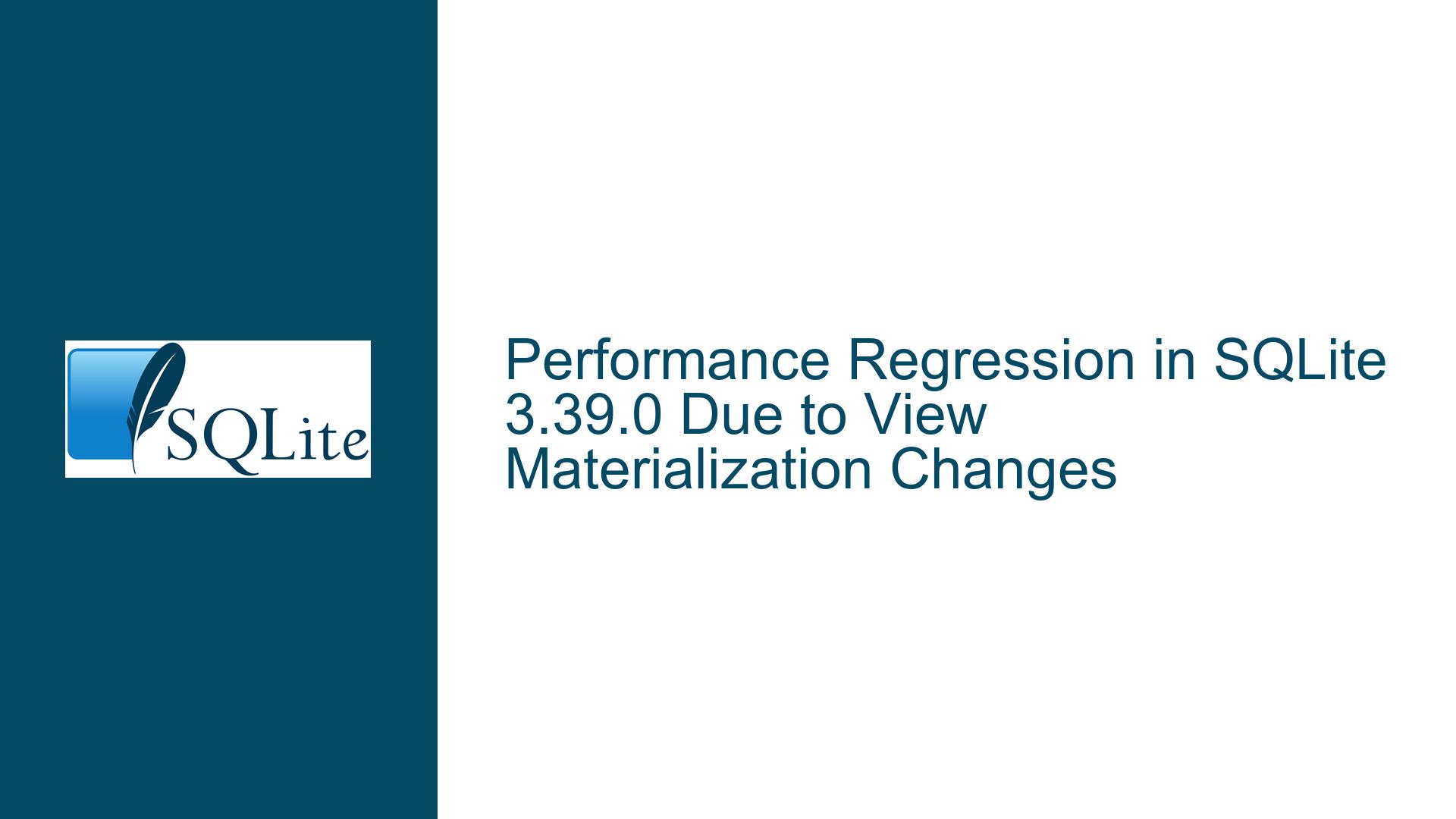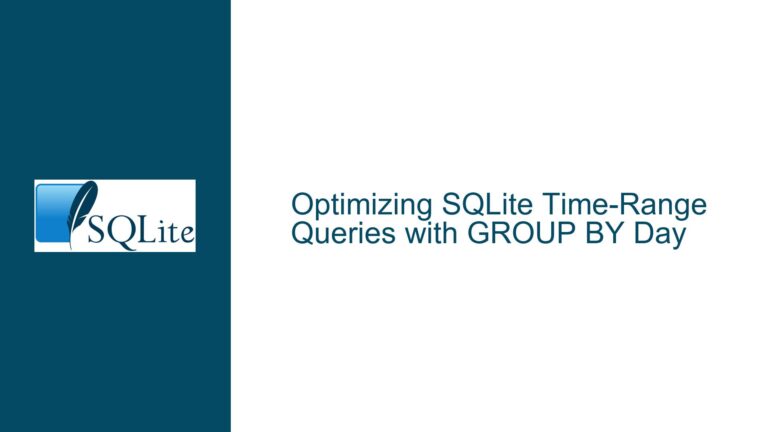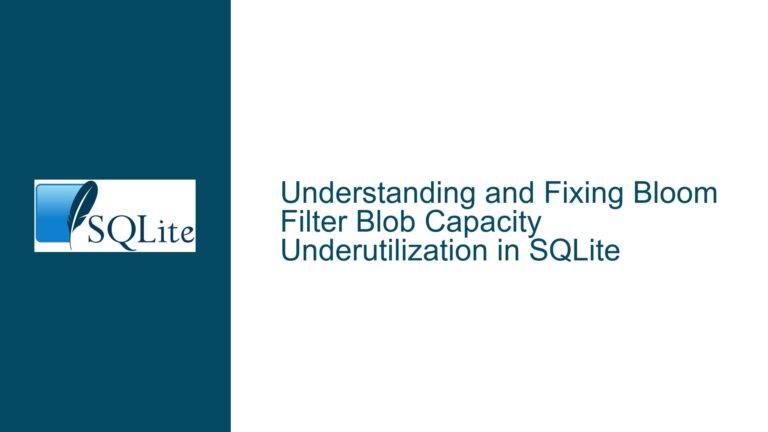Performance Regression in SQLite 3.39.0 Due to View Materialization Changes
Understanding the Performance Regression in SQLite 3.39.0
The performance regression observed when upgrading from SQLite 3.38.5 to 3.39.0 is a critical issue that affects queries involving views. The regression manifests as a significant slowdown in query execution times, particularly when views are used in conjunction with JOIN operations. This issue is rooted in changes to the query optimizer’s behavior, specifically around how views are materialized and flattened into the outer query. The problem is exacerbated when the query involves complex JOIN conditions and indexed columns, as seen in the provided schema and query.
The schema involves three main tables: macro_transactions, pypi_packages, and pypi_packages_macro_association. These tables are interconnected through foreign keys and indexed columns, which are crucial for efficient query execution. The views committed_macro_transactions and committed_pypi_packages_macro_association are designed to filter and join data from these tables, providing a simplified interface for querying committed transactions and their associated packages.
The query in question joins the pypi_packages table with the committed_pypi_packages_macro_association view, filtering on specific conditions such as cname, source_id, and transaction IDs. In SQLite 3.38.5, this query executes efficiently due to the optimizer’s ability to flatten the view into the outer query, leveraging indexes effectively. However, in SQLite 3.39.0, the optimizer’s behavior changes, leading to the materialization of the view and a subsequent performance degradation.
Root Causes of the Performance Regression
The primary cause of the performance regression is the introduction of a new query flattener restriction in SQLite 3.39.0, specifically restriction 29b. This restriction prevents the optimizer from flattening views into the outer query if there is an ON clause on the join of the view. The restriction was added to support the newly introduced RIGHT JOIN functionality, which required changes in how queries are analyzed and optimized.
In SQLite 3.38.5, the optimizer could flatten the committed_pypi_packages_macro_association view into the outer query, allowing it to use indexes efficiently and avoid materializing the view. This resulted in a query plan that scanned the pypi_packages table using the pypi_packages_source_id_cname index and searched the pypi_packages_macro_association table using the pypi_packages_macro_association_package_id index. The query executed in a fraction of a second, as evidenced by the timer output.
In SQLite 3.39.0, the optimizer is forced to materialize the committed_pypi_packages_macro_association view due to the new restriction. This materialization involves scanning the pypi_packages_macro_association table and performing additional searches on the macro_transactions table, leading to a significantly slower query plan. The query plan now includes a MATERIALIZE step for the view, followed by searches on the pypi_packages and pypi_packages_macro_association tables. This change results in a query execution time that is orders of magnitude slower than in SQLite 3.38.5.
The impact of this regression is particularly severe for queries that involve complex views and JOIN operations, as seen in the provided example. The materialization of the view not only increases the computational overhead but also prevents the optimizer from leveraging indexes effectively, leading to suboptimal query plans and slower execution times.
Resolving the Performance Regression: Steps, Solutions, and Fixes
To address the performance regression, several approaches can be taken, ranging from temporary workarounds to permanent fixes. The most effective solution depends on the specific use case and the constraints of the application.
Workaround: Moving ON Clause to WHERE Clause
One immediate workaround is to move the JOIN condition from the ON clause to the WHERE clause. This change bypasses the query flattener restriction and allows the optimizer to flatten the view into the outer query, resulting in a more efficient query plan. The modified query would look like this:
SELECT p.id, p.source_id, p.cname, p.project_name,
pa.version, pa.json_path, p.summary
FROM pypi_packages p
INNER JOIN committed_pypi_packages_macro_association pa
WHERE pa.package_id = p.id
AND p.cname='numpy'
AND p.source_id=2
AND pa.committed_tran_create <= 369
AND (pa.committed_tran_delete is null
OR pa.committed_tran_delete > 369);
This workaround provides a significant performance improvement, as it allows the optimizer to use indexes effectively and avoid materializing the view. However, it requires modifying the query syntax, which may not be feasible for all applications.
Workaround: Eliminating Views in Favor of JOINs
Another workaround is to eliminate the use of views altogether and replace them with explicit JOINs in the query. This approach involves rewriting the query to join the underlying tables directly, bypassing the view entirely. The modified query would look like this:
SELECT p.id, p.source_id, p.cname, p.project_name,
pa.version, pa.json_path, p.summary
FROM pypi_packages p
INNER JOIN pypi_packages_macro_association pa
ON pa.package_id = p.id
INNER JOIN macro_transactions rc
ON rc.id = pa.tran_create
AND rc.completed is not null
LEFT JOIN macro_transactions rd
ON rd.id = pa.tran_delete
AND rd.completed is not null
WHERE p.cname='numpy' AND p.source_id=2
AND pa.tran_create <= 369
AND (pa.tran_delete is null OR pa.tran_delete > 369);
This workaround also provides a significant performance improvement, as it allows the optimizer to use indexes effectively and avoid materializing the view. However, it requires significant changes to the application code, which may not be feasible for all applications.
Permanent Fix: Upgrading to SQLite 3.40.0 or Later
The most effective and permanent solution is to upgrade to SQLite 3.40.0 or later, where the issue has been fixed. The fix involves relaxing the query flattener restriction for cases where it is not required, allowing the optimizer to flatten views into the outer query even when there is an ON clause on the join of the view. This fix restores the query optimizer’s behavior to that of SQLite 3.38.5, resulting in efficient query plans and fast execution times.
To confirm that the issue has been resolved, you can build SQLite from the latest source code or download a pre-built binary of SQLite 3.40.0 or later. After upgrading, you can run the original query and verify that the query plan and execution time match those of SQLite 3.38.5.
Conclusion
The performance regression in SQLite 3.39.0 is a significant issue that affects queries involving views and JOIN operations. The root cause of the regression is a new query flattener restriction introduced to support RIGHT JOIN functionality. This restriction prevents the optimizer from flattening views into the outer query, leading to suboptimal query plans and slower execution times.
Several workarounds are available, including moving the ON clause to the WHERE clause and eliminating views in favor of JOINs. However, the most effective and permanent solution is to upgrade to SQLite 3.40.0 or later, where the issue has been fixed. By upgrading, you can restore the query optimizer’s behavior to that of SQLite 3.38.5, resulting in efficient query plans and fast execution times.





